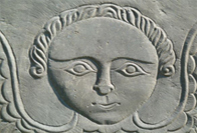HisTory and Legacy
Legacy History - Edward B. Russell & CompanyThe Preservation Collaborative, Inc. is a legacy descendent of a sixth generation company which had its origins in the mid nineteenth century. From that time, it developed into a large operation, downsized significantly after the great depression and finally was reborn by the present company owner.
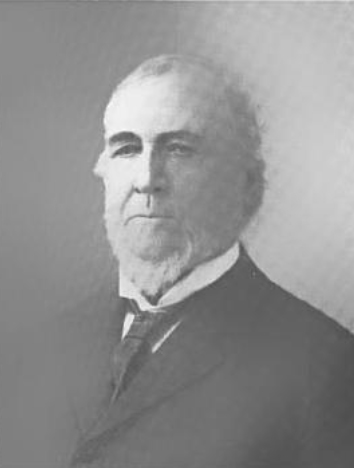 Born in 1820, Edward B. Russell was the son of a prosperous Maine politician. He grew up in Yarmouth while his father served as a Representative to the General Court, and later was Secretary of the State of Maine. Refusing to attend college, Edward came to Boston in the mid 1830s to make a living as a grocer and clerk. He was first employed by Hurd, Hutchins and Skinner, a well known dealer in West India goods and groceries. A hard worker, he became the bookkeeper for their Charlestown, Massachusetts, store. Perfecting his skills, he later worked for a local bank nearby for two years.
Born in 1820, Edward B. Russell was the son of a prosperous Maine politician. He grew up in Yarmouth while his father served as a Representative to the General Court, and later was Secretary of the State of Maine. Refusing to attend college, Edward came to Boston in the mid 1830s to make a living as a grocer and clerk. He was first employed by Hurd, Hutchins and Skinner, a well known dealer in West India goods and groceries. A hard worker, he became the bookkeeper for their Charlestown, Massachusetts, store. Perfecting his skills, he later worked for a local bank nearby for two years.
Not happy with either station, Edward set off to begin his own enterprise. In 1842, he partnered with local resident David Dow under the name Dow and Russell. They dealt in off-the-ship goods on Commercial Street in Boston. Unfortunately, their timing was poor. The panic of 1837 left a weak economy and the two were only marginally profitable. The firm dissolved two years later, just as the market started to turn. Undaunted, Dow regrouped and later formed David Dow & Company, a competitive West India goods dealer. He later reeled in the successful return of the economy. Edward Russell meanwhile, had other ideas.
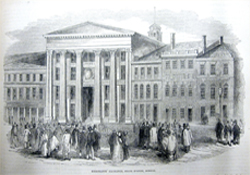 In 1844, Edward Russell opened The Mercantile Agency, a credit reporting operation which was founded directly as a result of the 1837 Panic. Three years earlier, noted abolitionist and merchant Lewis Tappan of New York noted the Panic had been caused by rampant abuse of credit. There was no central reporting agency to justify the reliability of both commercial enterprises and persons. That changed when he founded a business by the same name in 1841. As a trusted merchant and having a miracle to a plaguing problem, he helped speed the economic recovery. He allowed Russell to use the business’ name to get him off the ground, but the two were not connected.
In 1844, Edward Russell opened The Mercantile Agency, a credit reporting operation which was founded directly as a result of the 1837 Panic. Three years earlier, noted abolitionist and merchant Lewis Tappan of New York noted the Panic had been caused by rampant abuse of credit. There was no central reporting agency to justify the reliability of both commercial enterprises and persons. That changed when he founded a business by the same name in 1841. As a trusted merchant and having a miracle to a plaguing problem, he helped speed the economic recovery. He allowed Russell to use the business’ name to get him off the ground, but the two were not connected.
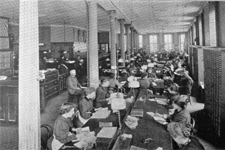 Russell’s business grew steadily over the next half century. In 1853, the name was changed to Edward B. Russell and Company to reflect the independent nature of his business. They moved from their original office at 25 Kilby Street in Boston to more spacious quarters at the famous Boston Merchant Exchange Building at 55 State Street. Four satellite operations were founded including: Lynn and Worcester Massachusetts; Bangor and Portland, Maine. By 1895, they had one hundred twenty two employees covering all of New England. They were the largest independent credit reporting agency under the Mercantile Agency. That firm, restructured into the R. G. Dun & Company, approached Russell about selling. Two years later in 1897, Russell retired after more than fifty years in the same business. His employees and locations were absorbed into the larger company which formed a massive empire. Following a mid 20th century merger, the firm became Dun and Bradstreet, a major Wall Street firm.
Russell’s business grew steadily over the next half century. In 1853, the name was changed to Edward B. Russell and Company to reflect the independent nature of his business. They moved from their original office at 25 Kilby Street in Boston to more spacious quarters at the famous Boston Merchant Exchange Building at 55 State Street. Four satellite operations were founded including: Lynn and Worcester Massachusetts; Bangor and Portland, Maine. By 1895, they had one hundred twenty two employees covering all of New England. They were the largest independent credit reporting agency under the Mercantile Agency. That firm, restructured into the R. G. Dun & Company, approached Russell about selling. Two years later in 1897, Russell retired after more than fifty years in the same business. His employees and locations were absorbed into the larger company which formed a massive empire. Following a mid 20th century merger, the firm became Dun and Bradstreet, a major Wall Street firm.
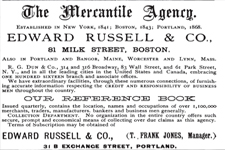 His father having sold his mercantile agency, (Edward) Berry Russell continued the business by switching to the manufacture of envelopes. They operated under the same name which was shortened to E. B. Russell and Company around 1910. They remained in the heart of Boston, moving near the Custom House at 174 High Street. This large building was in the heart of a blooming commercial district. He continued to head the business until the 1920s after which his nephew, Russell Aude Hayward, took over. Hayward continued the manufacturing operation until the mid 1970s. Rising costs resulted in the close of that operation. The business legacy has since passed though remaining decedents to the present owner.
His father having sold his mercantile agency, (Edward) Berry Russell continued the business by switching to the manufacture of envelopes. They operated under the same name which was shortened to E. B. Russell and Company around 1910. They remained in the heart of Boston, moving near the Custom House at 174 High Street. This large building was in the heart of a blooming commercial district. He continued to head the business until the 1920s after which his nephew, Russell Aude Hayward, took over. Hayward continued the manufacturing operation until the mid 1970s. Rising costs resulted in the close of that operation. The business legacy has since passed though remaining decedents to the present owner.
The modern enterprise, Preservation Collaborative, Inc., traces its roots to the legacy of Edward B. Russell and Company. Ryan D. Hayward, a descendent of Edward Russell and family, reestablished a small business to provide quality preservation services to those who need it. The firm adopted the present name in 2011 to better focus on their services and strives to continue what others started over one hundred seventy years ago.
